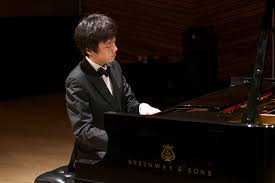Maidstone Symphony Orchestra
Mote Hall, Maidstone, Saturday 10 October 2015
An ambitious and meaty all-Russian programme – comprising three works all written within 50 years – got the first concert of the Maidstone Symphony Orchestra season off to a resounding start. And the star of the evening was most definitely Taek-Gi Lee, 19, whose approach to the notoriously challenging Rachmaninov third piano concerto was intense rather than passionate and that meant measured, poised, extraordinarily mature and thoughtful playing for one so young especially in the spectacular first movement cadenza, the luxuriant velvety adagio and the dramatic dive into the finale. Slight, straight-backed and immaculate in neatly buttoned dark suit Lee wowed the audience with oodles of technical prowess – small hands and lithe fingers often moving in a rapid blur – and, afterwards with boyish modesty. Brian Wright, always musically very supportive of young soloists, ensured that the orchestra provided a well balanced accompaniment despite the tricky bittiness of so many of the interjections, some of which occasionally lacked finesse.
The concerto was sandwiched between three dances, including the Sabre Dance from Khachaturian’s Gayane, and, after the interval Rimsky-Korsakov’s Scheherazade. The raw excitement of the familiar Sabre Dance worked its high speed magic with xylophone and woodwind going full tilt and strings vamping. Nothing is ever perfect in any concert – and there were one or two iffy moments in the first two dances – but that’s the joy of live music. It’s alive and dynamic. If you want predictable perfection then stay at home and listen to a CD recorded in lots of takes.
Scheherazade requires huge forces and we got them – six percussionists, harp and additional brass and woodwind. Rimsky-Korsakov was an outstandingly good orchestrator.
Brian Wright knows better than to resort to musical histrionics. Instead he allowed his players – especially the flute, piccolo and trumpets – to find and run with all those lovely orchestral colours and tonal contrasts. I shall long treasure, for example, that exquisite passage in the opening movement in which a bassoon melody is underpinned by a long low note from double basses. And it’s a real treat to hear those sorts of details coming through with clarity. At the same time there’s a lot of rich long-bowed string work in Scheherazade and this performance did it real justice. Orchestra leader Robin Brightman played the violin solos sensitively too (in duet with cellist Angela Migden at times) with his harmonics at the very end leading at least two people sitting near me to marvel aloud. Susan Elkin

